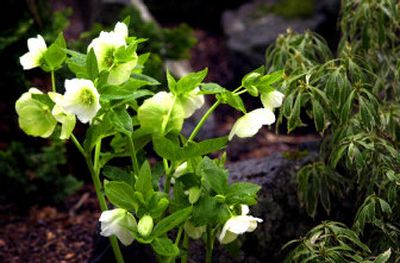Stinky helleborn in bloom

Spring came to Steve and Joan Hoitink’s South Hill garden several weeks ago when their stinking hellebore (Helleborus foetidus) began sending up its white-and cream-colored flowers. . Their Lenten Rose (Helleborus orientalis) and Christmas Rose (Helleborus niger) are not far behind. The blooms will nod gently in the wind for a month or more adding a backdrop to other early blooming plants and bulbs.
Hellebores are a woodland plant. Their clumps of evergreen somewhat-stiff foliage provide the shade garden with a steady green.
“They have been pretty all through the winter,” says Joan Hoitink, “And all through the summer it’s a handsome foliage plant.”
But it’s in the spring when the plants really shine. As soon as the ground has thawed and the temperatures moderate a bit, buds start forming amongst clumps of leaves. Soon clusters of white, cream, purple, pink and mauve flowers rise above the clumps brightening the still lifeless garden. The flowers can be 2 inches or more across and nod gently on the tip of a foot-tall stem. Because the showy part of the flower is actually a bract (like a poinsettia) with the true flower in its center, the blooms will last a month or more.
The common names of Christmas or Lenten Rose reflects this penchant for blooming early. In areas warmer than the Inland Northwest, the Christmas Rose blooms in early January, while we don’t usually see it until mid- to late-March. The Lenten Rose blooms in the early spring around Lent. The stinking hellebore gets its name from the fact its blooms have an odd odor to them.
Hellebores have gained in popularity in the past 20 years because they are very easy to crossbreed. Even in the garden, the plants cross breed and then reseed themselves with abandon under the right conditions. The Hoitinks dig and replant a number of seedlings each year. Breeders all over the world have been creating dozens of new flower and foliage colors particularly from the H. orientalis varieties. The flowers come in dozens of shades of dusty red, pink and even speckled patterns. Leaves can be gray green, variegated, or very close to black.
Growing hellebores is not difficult. They don’t like to be moved so put them somewhere they can live undisturbed. They need a soil rich in organic matter and medium shade. They can take morning sun during the summer and don’t mind full sun through the fall and winter when the leaves are off the trees above them. Once established, they are fairly drought tolerant and require no special feeding or pest management. Even the slugs leave them alone. The Hoitinks’ plants get no special treatment.
One note: It can take several years before they begin blooming so patience is needed until then.